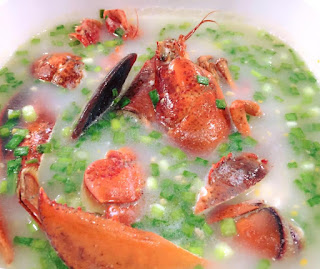Ingredients (serves 3 pax)
1 cup rice
2 pcs boston lobsters (chopped & cleaned)
6-8 pcs dried scallops (soaked & drained)
9 pcs fresh scallops
3-4 ltrs chicken stock
1 thumb ginger (julienned)
Sesame oil
Pepper (to taste)
Spring onion (garnish)
6 pcs wonton skin (garnish, optional)
Steps
1. Wash and freeze rice grains with a little water for a couple of hours.
2. Cut the wonton wrappers into strips, deep fry till crispy, set aside.
3. Boil the dried scallops in chicken stock for 20mins (also to include the soaking water) before adding the frozen grains.
4. Once the porridge boils, simmer for another 15mins, all in about 20mins. Add boston lobsters, fresh scallops, ginger and cook for 10mins, add salt to taste if necessary but I did not as the sweetness from the seafood is enough to flavour the porridge. Do not overcook the seafood, 10-12mins should be about right as the latent heat of the porridge will continue to cook them even when the pot is off the stove.
5. Drizzle some sesame oil, add a few dashes of pepper and sprinkle spring onions & fried wonton strips before serving.
6. Bon appétit!
Note
1. Freezing of the rice grains will break up the internal structure of the grain making it easier and faster to cook. No need to simmer long hours on the stove for the grains to absorb the flavouring of both the broth and ingredients.
2. I did not grind the grains like I did previously as I want to stick to the original presentation of the restaurant porridge as much as possible ie that of teochew porridge. Grinding and freezing the rice grains will yield the Cantonese type of porridge.
3. The amount of chicken stock to add depends on how soupy you want your porridge to be.
4. Can cook pumkin porridge as base but I like to stick to as original a recipe as I could from what I had at Orchid Seafood Restaurant.
5. Can use any type of lobsters.
6. Once cooked and if taking longer time to savour the dish, its best to ladle the lobsters and scallops out from the porridge onto a plate, just like how it is done in the restaurant to avoid overcooking of the seafood.
1 cup rice
2 pcs boston lobsters (chopped & cleaned)
6-8 pcs dried scallops (soaked & drained)
9 pcs fresh scallops
3-4 ltrs chicken stock
1 thumb ginger (julienned)
Sesame oil
Pepper (to taste)
Spring onion (garnish)
6 pcs wonton skin (garnish, optional)
Steps
1. Wash and freeze rice grains with a little water for a couple of hours.
2. Cut the wonton wrappers into strips, deep fry till crispy, set aside.
3. Boil the dried scallops in chicken stock for 20mins (also to include the soaking water) before adding the frozen grains.
4. Once the porridge boils, simmer for another 15mins, all in about 20mins. Add boston lobsters, fresh scallops, ginger and cook for 10mins, add salt to taste if necessary but I did not as the sweetness from the seafood is enough to flavour the porridge. Do not overcook the seafood, 10-12mins should be about right as the latent heat of the porridge will continue to cook them even when the pot is off the stove.
5. Drizzle some sesame oil, add a few dashes of pepper and sprinkle spring onions & fried wonton strips before serving.
6. Bon appétit!
Note
1. Freezing of the rice grains will break up the internal structure of the grain making it easier and faster to cook. No need to simmer long hours on the stove for the grains to absorb the flavouring of both the broth and ingredients.
2. I did not grind the grains like I did previously as I want to stick to the original presentation of the restaurant porridge as much as possible ie that of teochew porridge. Grinding and freezing the rice grains will yield the Cantonese type of porridge.
3. The amount of chicken stock to add depends on how soupy you want your porridge to be.
4. Can cook pumkin porridge as base but I like to stick to as original a recipe as I could from what I had at Orchid Seafood Restaurant.
5. Can use any type of lobsters.
6. Once cooked and if taking longer time to savour the dish, its best to ladle the lobsters and scallops out from the porridge onto a plate, just like how it is done in the restaurant to avoid overcooking of the seafood.
